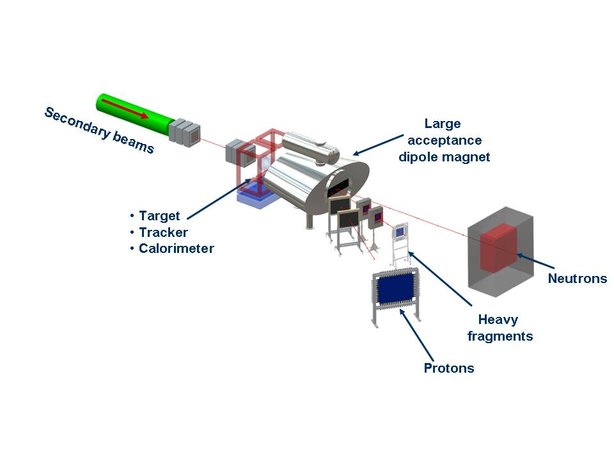Experimental Setup
The experimental method consists of producing high-energy radioactive beams (with typically a few hundred MeV/nucleon kinetic energy) and of a kinematically complete measurement of breakup reactions in secondary targets. The measurement is exclusive or kinematically complete in the sense that all reaction products with velocities close to the beam velocity and gamma-rays are detected. A schematic drawing of the detection setup is shown below.
Secondary beams at the FRS target are selected by the FRS according to their magnetic rigidity only, thus mixed secondary beams containing isotopes with similar mass-over-charge ratio are transported to the experimental area. The incident projectiles are uniquely identifed on an event-by-event basis by utilizing energy loss and time-of-flight measurements.
In a similar manner, the fragments produced through interactions with the reaction target are identifed. Here, the magnetic rigidity is determined from three position measurements defning the trajectories of the charged projectile residues in the magnetic field of a large-acceptance dipole magnet GLAD placed behind the target. Additional energy loss and time-of-flight measurements allow unique identifcation of the outgoing fragments and determination of their momenta. Several detectors, such as start detector, ToF wall, fiber detectors, Si detectors and ionisation chambers have been developed for this purpose.
Neutrons emitted from the excited projectile or excited-projectile-like fragments are kinematically focussed in the forward direction and detected with high effciency in the NeuLAND neutron detector. The momenta of the neutrons are determined from the time-of-flight and position information.
At the high beam energies used, the gamma-rays need to be detected with good angular resolution in order to minimize Doppler-broadening effects. To this goal, CALIFA detector is used. It is a gamma-ray calorimetar, spectrometer and also charged-particle detector. High-eenrgy protons produced in quasi-free scattering reactions are tracked with a dedicated tracking system surrounding the target.
More details can be found here.




